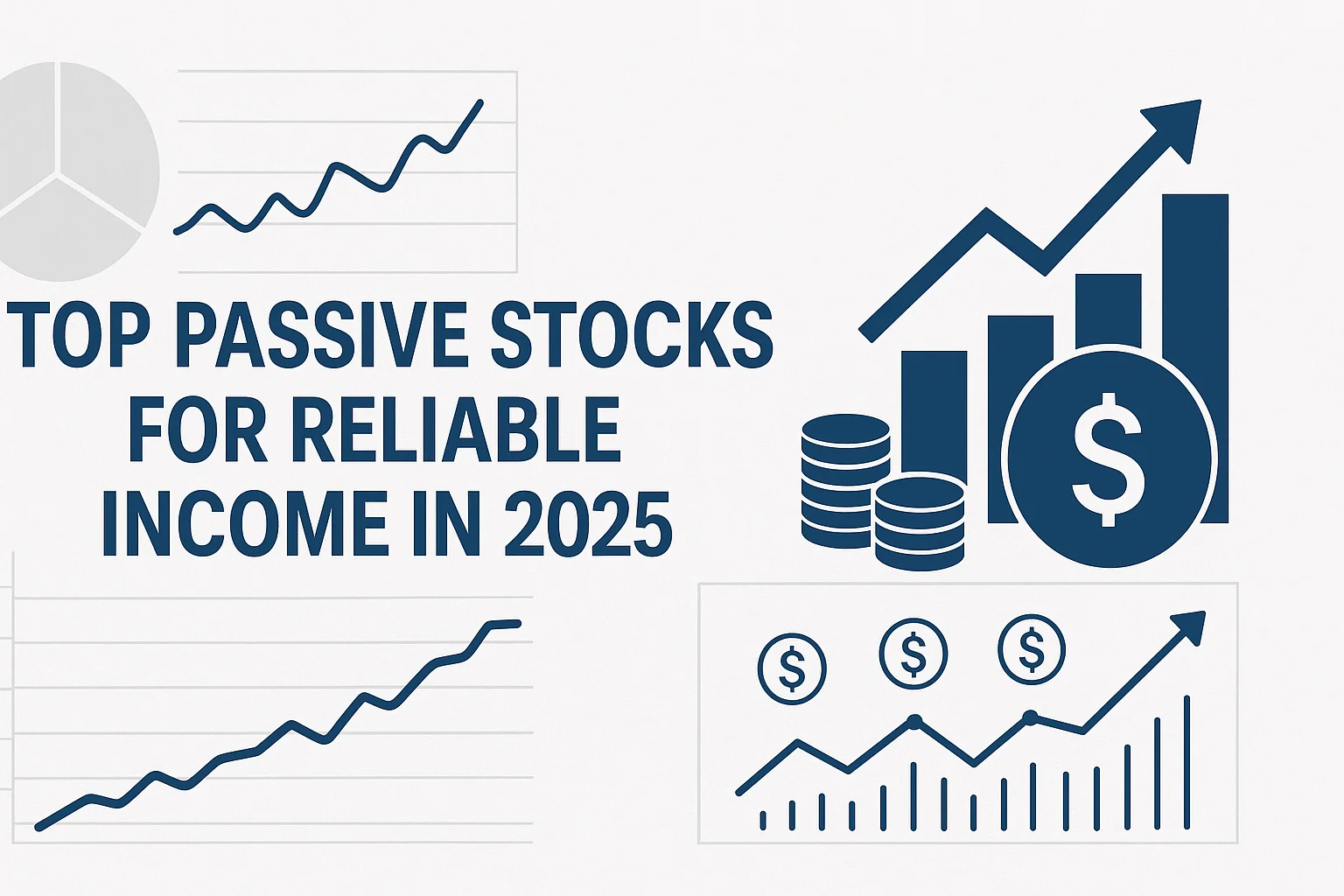In an increasingly uncertain global economy, investors are turning to passive income strategies that offer stability, consistency, and long-term growth. Among the most trusted methods is investing in passive stocks — companies with a proven track record of delivering dividends, strong cash flows, and resilient performance regardless of market volatility. For 2025, identifying the top passive stocks for reliable income is more important than ever.
Whether you’re a conservative investor planning for retirement or someone aiming to grow a steady secondary income, this guide highlights the top passive stocks worth considering in 2025 based on their history, financial health, and future outlook.
What Are Passive Stocks?
Passive stocks refer to shares of companies that generate steady income through regular dividends, minimal trading activity, and long-term holding strategies. These stocks are typically part of index funds, ETFs, or individual portfolios aimed at income rather than capital gains. They are not actively traded based on short-term market moves but are chosen for their long-term income-generating potential.
Key characteristics of passive stocks include:
- Consistent dividend payments
- Low volatility
- Strong balance sheets
- Established market presence
- Resilient business models
Why Passive Stocks Matter in 2025
2025 brings with it global inflation concerns, rising interest rates, and shifting monetary policies. Investors are increasingly focused on financial instruments that preserve capital while generating dependable income. Passive stocks are ideal for this environment because they offer:
- Protection from market downturns
- Regular income from dividends
- Lower management fees if part of ETFs
- Reduced stress from frequent trading decisions
Investing in top passive stocks allows individuals to benefit from market growth while earning consistent returns, even during turbulent times.
Criteria for Selecting Reliable Passive Stocks
When evaluating the best passive stocks for 2025, the following factors are critical:
- Dividend Yield: A higher yield reflects better income potential, but it must be sustainable.
- Dividend Growth: Companies that increase dividends annually reflect financial strength.
- Payout Ratio: A healthy payout ratio (40–60%) indicates the company is not over-distributing profits.
- Earnings Consistency: Strong historical earnings signal resilience.
- Debt Management: Low to moderate debt allows companies to weather economic downturns.
- Sector Stability: Utilities, consumer staples, and healthcare often offer stability.
Top Passive Stocks for Reliable Income in 2025
1. Johnson & Johnson (JNJ)
Sector: Healthcare
Dividend Yield (Est. 2025): 3.2%
Dividend Growth: 61 years consecutive increases
Johnson & Johnson remains one of the most reliable dividend payers in the healthcare sector. With diversified operations in pharmaceuticals, medical devices, and consumer health products, JNJ has weathered economic shocks and continued to reward shareholders. Its long history of dividend growth makes it an ideal passive stock for income seekers.
2. Procter & Gamble (PG)
Sector: Consumer Staples
Dividend Yield (Est. 2025): 2.7%
Dividend Growth: 67 consecutive years
P&G has built its brand portfolio with global household names like Tide, Pampers, and Gillette. Its dependable business model ensures stable revenues in both good and bad times. In 2025, it’s expected to continue its upward trajectory of dividend payments, solidifying its place in any passive income portfolio.
3. Realty Income Corporation (O)
Sector: Real Estate (REIT)
Dividend Yield (Est. 2025): 5.5%
Dividend Frequency: Monthly
Known as “The Monthly Dividend Company,” Realty Income is a REIT that owns commercial properties under long-term lease agreements. With a stable tenant base across retail, healthcare, and industrial sectors, it offers strong, recurring income — a perfect addition for dividend-focused investors.
4. PepsiCo (PEP)
Sector: Consumer Staples
Dividend Yield (Est. 2025): 3.0%
Dividend Growth: 50+ years
PepsiCo’s strength lies in its balanced portfolio between beverages and snacks, featuring products that are in constant consumer demand. This consistency has led to decades of reliable performance and dividend payments, making it a top contender in the passive stock category.
5. Duke Energy (DUK)
Sector: Utilities
Dividend Yield (Est. 2025): 4.4%
Dividend Growth: 15+ years
Utilities are often the backbone of income-focused portfolios, and Duke Energy stands out in 2025 due to its regulated revenue base and expansion into clean energy. With its commitment to renewable sources, Duke is positioning itself for long-term relevance while continuing to deliver solid dividends.
6. AbbVie Inc. (ABBV)
Sector: Pharmaceuticals
Dividend Yield (Est. 2025): 3.9%
Dividend Growth: 9 consecutive years since spin-off
Spun off from Abbott Laboratories, AbbVie has quickly earned investor confidence through robust earnings from drugs like Humira and Skyrizi. With expanding pipelines and strategic acquisitions, ABBV is poised to deliver continued dividend growth in 2025 and beyond.
7. McDonald’s Corporation (MCD)
Sector: Consumer Discretionary
Dividend Yield (Est. 2025): 2.5%
Dividend Growth: 47+ years
McDonald’s is more than a fast-food giant; it’s a dividend powerhouse. Its franchise model ensures predictable cash flows with minimal capital expenditure. With its focus on innovation, digital growth, and international expansion, McDonald’s remains a reliable passive income source.
8. Coca-Cola Company (KO)
Sector: Consumer Staples
Dividend Yield (Est. 2025): 3.3%
Dividend Growth: 62 years
Coca-Cola is a classic dividend aristocrat. Its global dominance, vast distribution network, and evolving product line ensure stability and growth. As health-conscious trends rise, Coca-Cola is investing in zero-sugar and healthy beverage alternatives, securing its long-term relevance.
9. Brookfield Infrastructure Partners (BIP)
Sector: Infrastructure / Utilities
Dividend Yield (Est. 2025): 5.8%
Structure: MLP (Master Limited Partnership)
BIP owns and operates critical infrastructure worldwide, including toll roads, data centers, and utilities. Its globally diversified revenue stream and inflation-linked contracts make it an attractive option for high-yield passive income seekers.
10. Vanguard High Dividend Yield ETF (VYM)
Sector: ETF (Diversified Sectors)
Dividend Yield (Est. 2025): 3.2%
Holdings: Includes JNJ, JPM, PG, etc.
For investors looking for broad exposure, VYM is an excellent passive ETF that tracks high-dividend stocks across sectors. It offers lower volatility, instant diversification, and consistent income — perfect for long-term, hands-off investing.
Diversification for Better Income Reliability
While investing in individual passive stocks can offer higher yields, it’s essential to diversify across:
- Sectors (healthcare, consumer staples, utilities)
- Geographies (domestic and international)
- Asset classes (stocks, REITs, ETFs)
This reduces risk, protects against industry-specific downturns, and ensures stable income from multiple sources.
Passive Stock Pitfalls to Avoid
Even with the best passive stocks, investors must remain cautious of:
- Dividend Traps: High yields with unsustainable earnings.
- Excessive Payout Ratios: Can signal future dividend cuts.
- Economic Sensitivity: Some sectors are still cyclical, even with dividend history.
- Neglecting Reinvestment: Reinvesting dividends enhances compounding and long-term returns.
Careful analysis, regular review, and avoiding overconcentration are key to successful passive investing.
Conclusion
As the financial landscape continues to evolve, the top passive stocks for reliable income in 2025 stand out not just for their yields but for their resilience, adaptability, and long-standing commitment to shareholders. Whether you’re building a retirement portfolio or simply looking for a steady secondary income stream, integrating these stocks into your investment strategy can provide peace of mind and financial stability.
From dividend aristocrats like Johnson & Johnson and Coca-Cola to high-yield REITs and ETFs, passive investing remains a dependable strategy for the year ahead. Stay informed, remain diversified, and let your investments work for you — passively but powerfully.


